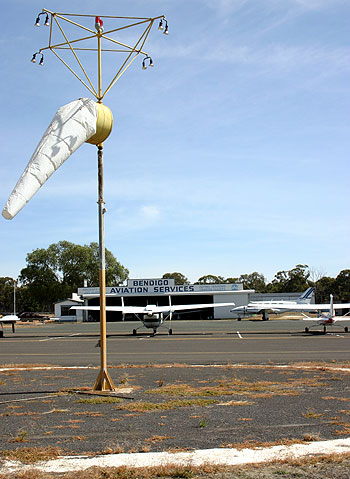
An
essential piece of equipment for all aerodromes is a Wind
Direction Indicator (WDI), universally known as the 'windsock'. At aerodromes
approved for night flying, an Illuminated Wind Indicator (IWI) is required.
Australian regulations require the primary WDI to be white in colour. Any additional windsocks not intended to be illuminated at night are coloured yellow and any additional IWIs are coloured white or another colour that is clearly visible when illuminated.
The photo above, taken at Bendigo, Vic, in March 2005, shows a typical
primary IWI. On top of the assembly are duplicated red hazard lights.
Below that are duplicated spotlights, arranged to shine on the windsock,
whatever its direction. The windsock itself is designed to swivel to
indicate the direction of the wind, and to be fully extended at a certain
wind speed - usually 15 knots.
The IWI stands in a 9 m diameter black circle outlined with a 1 m white
border, so as to make locating it from the air easier. Six evenly-spaced
white markers may be used in lieu of the border - click
here for an example.
Standards
require that runways served by a non-precision instrument approach (e.g.
VOR, NDB)
must have a windsock at the threshold of the runway, preferably 100
m upwind from the threshold. Nevertheless, aerodromes with runways less
than 1200 m in length need only have one, centrally-located windsock.
(Photo: Phil Vabre/CAHS collection)
Back
to the main Airports &
Aerodromes index
If
this page appears without a menu bar at top and left, click
here